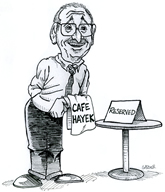Here’s a report on my GMU Econ colleague Bryan Caplan and his case for housing deregulation. A slice:
“Anger is his muse,” Caplan said, describing how his father spends hours listening to talk radio, furious at foreigners “for selling us stuff.”
The elder Caplan’s nostalgia is familiar across the Rust Belt, where officials in President Donald Trump’s administration promise that tariffs and factories can revive lost prosperity. But the younger Caplan, one of the country’s most prominent libertarian economists, and also one of its loudest champions of housing deregulation, insists that’s the wrong lifeline.
The real path to millions of blue-collar jobs, he argues, is letting Americans build more homes. He thinks that housing deregulation is an “almost perfectly tailored fit” to address the plight of the non-college-educated male, a significant demographic in the Rust Belt states.
The government doesn’t really have any business second-guessing sourcing decisions, and when it does so, it will make the country poorer on net. Some industries will benefit from protectionism, yes, but do you really think a U.S. business didn’t already consider U.S. suppliers when it was making its sourcing decision? Maybe U.S. suppliers don’t exist, maybe they’re too expensive, maybe they’re not reliable — I don’t know why, and neither does the government.
Meanwhile, the U.S. government is currently enacting protectionist policies for every country around the globe, and Michael has now written thousands of words in this exchange without addressing them. Does he support the massive tariffs on trade-surplus partner Brazil because Trump is mad about Jair Bolsonaro? Does he support the higher tariffs on India over Russian oil purchases, pushing India toward China, while the China “truce” continues even though China buys more Russian oil than India does? Does he support enormous tariffs on metals and other inputs to domestic manufacturing? Does he support tariffs on coffee, bananas, and other natural products that simply do not grow here in large amounts? Does he support the 39 percent “reciprocal” rate on Switzerland, which had basically no tariffs on U.S. goods at all, and the other “reciprocal” rates that are generally far higher than foreign rates levied against U.S. goods? Does he support the billion-dollar tariff bills foisted on American automakers? Does he think the $150 billion tax increase that the White House is bragging about is beneficial to the economy? Does he support the national-emergency declaration the president is claiming as a blank check to do all of this unilaterally?
At some point, protectionists should have to comment on real life.
James Pethokoukis is correct: “Mimicking China isn’t how the US should race against China.” A slice:
It’s a real bummer that Donald Trump’s economic strategy is starting to look uncomfortably like … the Chinese model it claims to counter. The US president has attempted to push out corporate leaders and Wall Street economists, extracted “golden shares” in firms such as U.S. Steel, claimed stakes in critical-mineral producers, such as a 15-percent holding in MP Materials, and promised to steer $1.5 trillion in investment pledges from allies.
Your editorial “Now Trump Wants an Export Tax” (Aug. 12), about the president’s demand for a 15% cut from two companies’ chip sales to China, refers to this as “an export tax that Congress didn’t authorize.” That’s correct as far as it goes: The charge almost certainly would be considered a tax, and Congress didn’t authorize it. But such authorization would be irrelevant here. The taxing power under the Constitution is Congress’s, but the Export Clause provides that “No Tax or Duty shall be laid on articles exported from any State.” No exceptions. Congress itself therefore couldn’t impose a tax on exports, and it should follow that Congress can’t wave a magic wand to turn an unconstitutional act by the executive into a constitutional one.
Em. Prof. Erik M. Jensen
Jay Nordlinger writes about Walter Lippmann.
Kenneth Rogoff warns of the dangers of the U.S. government’s fiscal incontinence. Two slices:
The past few years have cast serious doubt on those assumptions. For starters, bond markets have become far less submissive, and long-term interest rates have risen sharply on ten- and 30-year U.S. Treasury bonds. For a big debtor like the United States—the gross U.S. debt is now nearly $37 trillion, roughly as large as that of all the other major advanced economies combined—these higher rates can really hurt. When the average rate paid rises by one percent, that translates to $370 billion more in annual interest payments the government must make. In fiscal year 2024, the United States spent $850 billion on defense—more than any other country—but it spent an even larger sum, $880 billion, on interest payments. As of May 2025, all the major credit-rating agencies had downgraded U.S. debt, and there is a growing perception among banks and foreign governments that hold trillions of dollars in U.S. debt that the country’s fiscal policy may be going off the rails. The increasing unlikelihood that the ultralow borrowing rates of the 2010s will come back any time soon has made the situation all the more dangerous.
There is no magic fix. U.S. President Donald Trump’s efforts to place the blame for high rates on the Federal Reserve Board are deeply misleading. The Federal Reserve controls the overnight borrowing rate, but longer-term rates are set by vast global markets. If the Fed sets the overnight rate too low and markets expect inflation to rise, long-term rates will also rise. After all, unexpectedly high inflation is effectively a form of partial default, since investors get repaid in dollars whose purchasing power has been debased; if they come to expect high inflation, they will naturally require a higher return to compensate. One of the main reasons governments have an independent central bank is precisely to reassure investors that inflation will remain tame and thereby keep long-term interest rates low. If the Trump administration (or any other administration) moves to undermine the Fed’s independence, that would ultimately raise government borrowing costs, not lower them.
…..
As debt debates became highly politicized, economists who questioned the lower-rates-forever orthodoxy were shunned or ignored. Yet anyone looking at the long history of interest-rate fluctuations would have recognized that a return to higher rates was a distinct, indeed likely, possibility. Consider the interest rate on ten-year inflation-indexed U.S. Treasury bonds, which are often used as a measure of the real interest rate in the economy. The rate fell by roughly three percentage points between September 2007 and September 2012, a collapse that can hardly be explained by slow-moving trends such as demographic decline and falling productivity. A far more plausible explanation was the prolonged effects of the global financial crisis and its aftermath. As with other past financial crises, these effects would eventually end, and one might reasonably have guessed that the era of ultralow interest rates would end as well.
Yet even conceding all of those points, I disagree with Gallagher’s prescription of sending most Chinese students back home or not letting them into our universities in the first place. He looks at only one side of the ledger — the costs of American universities educating Chinese students — without considering how this arrangement is to our benefit but to China’s detriment.
The students we’d be keeping out would still go to college — and many of them would still receive advanced degrees in science and technology — only at less prestigious universities in China, which is already graduating far more STEM Ph.D.s than the United States. And it has the capacity to graduate many more if it needs to. So keeping Chinese students out of the United States may be more of a wash than Gallagher would hope.
But what if a great many Chinese students stayed in the United States after finishing their education? If that were the case, we could poach much of China’s best talent in STEM fields, train them in better universities than China has, and apply their skills to advancing America’s cutting-edge science and technology rather than China’s. We could hurt the CCP with brain drain and boost our own competitiveness at the same time. Well, I have some good news: That’s already happening.
Chinese students currently make up 16 percent of all STEM Ph.D. seekers in the United States. In artificial intelligence fields, their share is 27 percent. Of the 15,800 Chinese students that received science and engineering doctorates from U.S. schools from 2017 to 2019, 13,150 of them remained in the United States five years later. That’s a “stay rate” of 83 percent, the second-highest of any country of origin after India. Those Ph.D. holders who stay aren’t in the “scientific and leadership class” of China, as Gallagher alleges. They’re in the scientific and leadership class of America.



